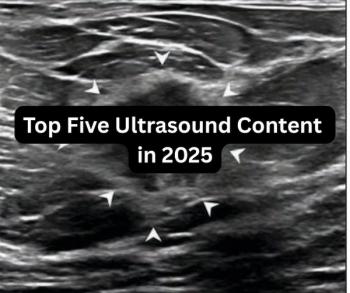
Large Study Shows Mixed Results in Comparison of DBT and Digital Mammography
In a large retrospective study involving over 523,000 digital breast tomosynthesis (DBT) exams and over one million digital mammography (DM) exams, researchers found that DBT was associated with significantly lower recall rates but showed no advantage over DM in the diagnosis of interval or advanced breast cancer.
Digital breast tomosynthesis (DBT) provided significantly lower recall rates than digital mammography (DM) in three rounds of successive screening examinations, but no significant difference in the detection of interval or advanced cancers, according to newly published data drawn from 58 breast imaging facilities in the Breast Cancer Surveillance Consortium.
For the study, recently published in
In the first round of screening, DBT had a recall rate of 7.5 in comparison to 10.9 for DM. The researchers also noted lower recall rates for DBT in the second round (6.9 vs. 8.6) and third round of screening (6.1 vs. 7.3).
“In our study, the difference in recall rate between the two imaging modalities was greatest in round 1. Although the difference in recall rate remained significantly different between modalities, it decreased over subsequent screening rounds,” pointed out Brian L. Sprague, Ph.D., who is affiliated with the Departments of Radiology and Surgery at the University of Vermont Cancer Center in Burlington, Vermont, and colleagues. “This attenuating pattern may be explained by the relatively high DM recall rate in round 1, which decreased on successive screening rounds – likely reflecting the value of comparison images from multiple prior screening rounds in reducing recall rate.”
(Editor’s note: For related content, see “
The researchers noted that DBT had a higher cancer detection rate than DBT with three or more successive screenings (a difference of .6 per 1,000 examinations). However, they found no significant differences in the sensitivity rate with the modalities. The study authors also saw no differences between DBT and DM in the detection of interval or advanced cancers.
“It is possible that the elevated cancer detection observed with DBT may predominantly represent slow-growing cancers that would not have arisen as interval or advanced cancers before the next screening examination,” suggested Sprague and colleagues. “Alternatively, additional follow-up examinations and increased sample size may be required to detect small reductions in interval or advanced cancer rates between DBT and DM, particularly if the differences are limited to subgroups of women, such as those with extremely dense breasts and high breast cancer risk.”
In an
“DBT is replacing DM as the imaging modality of choice for routine screening in the United States, but this has not been the case in population-based European screening programs,” pointed out Dr. Skaane, a professor emeritus at Oslo University Hospital in Norway. “One reason for non-implementation of DBT as a routine screening tool for women at average risk in Europe has been the mixed results on statistically significant reduction of interval cancers and associated lack of a reduction in advanced cancer rates. Consequently, there might be a potential for over-detection (over-diagnosis) and over-treatment.”
In regard to study limitations, the researchers noted a lack of randomization and conceded that residual confounding may have affected the study findings. Acknowledging small sample sizes for interval and advanced cancer outcomes, the study authors said they could not exclude the possibility of small but clinically significant differences between interval and advanced cancer detection rates.
Newsletter
Stay at the forefront of radiology with the Diagnostic Imaging newsletter, delivering the latest news, clinical insights, and imaging advancements for today’s radiologists.




























